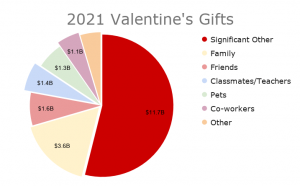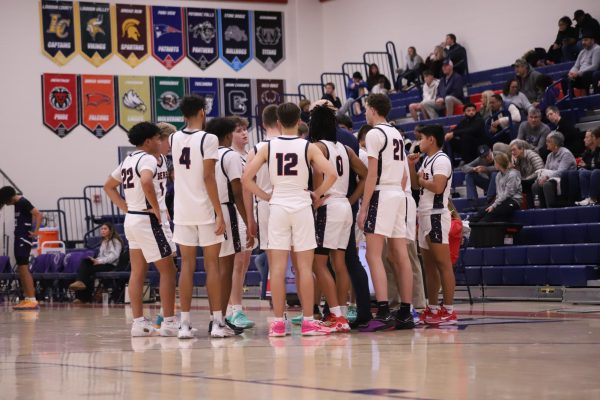Valentine’s Day: Is love actually in the air?
Valentine’s Day, arguably one of the most romantic days of the year, is a day that is adored and scorned by millions of people.
Happy couples and hopeless romantics will claim it’s the ultimate day of love, and heartbroken and lonely people will look at it with disdain. Then there are, of course, the new romantics, who are too busy dancing and believe the best people in life are free — they naturally gravitate towards their friends with ‘Galentine’s Day,’ or just spend all their money on their friends and family on Valentine’s Day.
People hold Valentine’s Day with deep love, contempt or indifference — but why is that? With Feb. 14 recently passing, it is the perfect time to dissect this romantic (for some) holiday.
The history of Feb. 14 is tumultuous, to say the least. According to some historians, it was originally a day in Ancient Rome dedicated to running around naked and beating women into fertility during the Lupercalia festival — not exactly the most romantic thing in the world.
During the third century CE, a man named Valentine was executed on Feb. 14 after being imprisoned by the Roman emperor for secretly marrying Christian couples. Legend has it that Valentine tutored a blind girl named Julie, the daughter of his jailor. One night, God restored Julia’s eyesight after she and Valentine prayed about it.
The day he was executed, Valentine gave a letter to Julia signed, “From your Valentine.” The Catholic Church declared him a saint who was martyred on Feb. 14, and over the years, Lupercalia came to a halt as people instead chose to honor Saint Valentine in the middle of the winter month.
Somehow, over the years, Saint Valentine’s Day became a day of celebrating love and relationships. The oldest surviving Valentine in English is from 1477, written by a woman in Norfolk, England. Over the next few centuries, this day of love started to become more widespread.
Famously, Shakespeare’s Ophelia mentions this holiday in “Hamlet,” singing “Tomorrow is Saint Valentine’s Day.” By 1784, London Society published a collection of poem and song ideas for lovers to send to each other on Valentine’s Day.
What turned into nothing but pure romance morphed into a big way to make money. In the 1840s, ads for Valentine’s gifts began popping up in American newspapers. These gifts ranged from extravagant cards to expensive jewelry. By 1847, the first printed complaint about this day of romance was posted in The New York Daily Tribune, with the writer complaining that the business aspect of the holiday took away the mystery and meaning of the day.
Perhaps this fed up writer was right: Valentine’s Day has become way too over-marketed. One of the biggest reasons there are such strong, negative feelings towards the holiday is that corporations and businesses feverishly market it to us during the winter.
For many, Hallmark brings to mind cheesy movies with clichéd meet-cutes, leaving the multi-billion dollar corporation, Hallmark Cards, forgotten.
With a revenue of around $4 billion, this holiday empire built their whole brand around the love of specific holidays, including Valentine’s Day, all of which are coined “Hallmark Holidays” — days that exist for commercial purposes.

Founded by Joyce Clyde Hall, Hallmark Cards began selling Valentine’s postcards in 1910. By 1916, the first of Hallmark’s Valentine’s Day cards hit stores, and since then it’s grown into a massive corporation. The Hall Family was named in 2015’s Richest Families by Forbes.
The National Retail Federation predicted Americans would spend a total of $21.8 billion on Valentine’s Day this year, amounting to about $164.76 per consumer. This is a notable difference from last year, with the Federation having found Americans spent a whopping $27.8 billion for Valentine’s day, which was pre-pandemic.

This high price tag is a major factor in people’s anger towards the day. When one sees prices for certain items rise around this time, such as roses, it’s natural to get annoyed. That being said, this price inflation isn’t always about corporate greed, it mainly has to do with supply and demand.
Advertisements are pushed onto the public around the holiday to a nauseating extent. These ads force commercialization onto consumers, telling them that the more money spent shows more love.
At the end of the day, expensive chocolates and flowers aren’t going to last. Why push it? Society tells a person that their love is measured in dollars; the bigger the diamond, the more love one has for another.
Why is it shameful to spend the day loafing around with loved ones, eating chocolate and watching your favorite rom-coms? One should demonstrate their love through actions, not money.
It’s time to return to the classic romance of this day, where love was demonstrated by action and words, not corporate greed and commercialization.














